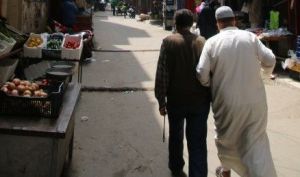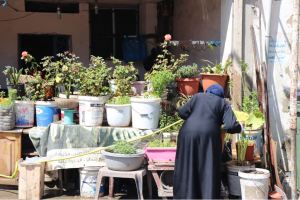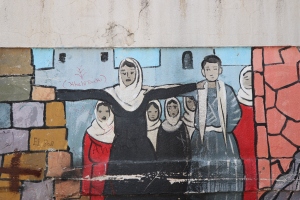In Part Two of this two-part series examining class-based inequality that can be both ignored and exacerbated by humanitarian programmes and aid workers, Dr Carpi draws on research conducted for the Southern Responses to Displacement project and argues that economic changes brought about by the introduction of a humanitarian economy of consumerism and labour in Akkar, North Lebanon, did not bring sustainable benefits. Existing demographic and social class divides, coupled with dominant humanitarian narratives and practices, influence the conceptualisations and treatment of migrants, migration, refugees. Dr Carpi further argues that without focused reflection on the impact of humanitarian programmes on existing and developing class-based inequalities, the divides between rich and poor, particularly for refugees experiencing protracted displacement and the departure of many humanitarian programmes, will be exacerbated.
You can read Part One of this series Bringing Social Class into Humanitarian Debates: The Case of Northern Lebanon – Part One here.
If you find this piece of interest you can access the recommended reading list at the end of it or access our Thinking Through the Global South series.
Bringing Social Class into Humanitarian Debates: The Case of Northern Lebanon – Part Two – The Hidden Role of Social Class
By Estella Carpi, Research Associate, Southern Responses to Displacement research project.
As noted in the Part One of this two-part piece, Akkar in Northern Lebanon experienced economic growth following the arrival of INGOs in the area responding to the arrival of Syrian refugees since 2012. However, this economic growth was not experienced equally across social classes in Akkar. Wealthier locals benefited from the lower cost of Syrian labour and international aid workers accessing housing, car rental and other consumables. Poorer locals, in competition with Syrian refugees for employment, felt increasing pressure and competition for work and livelihoods.
Against this backdrop, the humanitarian economy of consumerism and labor has not brought durable benefits to Akkar. The arrival of humanitarian agencies has not transformed Halba from an administrative hub into a consumption city. Despite an unprecedented humanitarian presence due to the Syrian crisis, the overall market demand has barely increased. As a local resident argued,[11] at the beginning of the refugee influx many residents opened new shops, but they eventually shut down as the rent was expensive and customers were few. Similarly, the resources needed for the functioning of the humanitarian system were largely outsourced. By the same token, international newcomers — from 2012 to 2015 — seldom frequented Halba for entertainment and consumption purposes. Due to the strict politics of work permits and recent NGO employment policies, which follow tougher national measures also towards upper and middle classes migration labor, Lebanese nationals now reportedly make up 90% of INGO and local NGO staff.[12] Moreover, most local and international NGO practitioners who work in Halba live in Tripoli, or in the nearby village of al-Qobaiyat, which is comparatively wealthier.
“In Qobaiyat people can find alcohol more easily and there are more cafes and restaurants. We don’t enhance the business volume in Halba, which remains a place for peasants; we go elsewhere for shopping,”
recounted a local aid worker.[13]
The character of Halba’s economy is hard to capture due to the scarcity of quantitative data.
“Halba has direct contact with international humanitarian organizations and that is an asset as it gets more resources than hamlets,”
noticed Halba’s governor.[14]
Likewise, the Syrian refugees who reside in Halba are considered wealthier than the refugees who opt for rural life. In this regard, an aid worker affirmed,
“We don’t have many projects in Halba, because the refugees in this city are generally less vulnerable. They used to live in cities inside Syria, representing advantaged classes and providing skilled work.”[15]
The burden placed on Akkar’s poor infrastructure as a result of the demographic growth spurred by the arrival of Syrian refugees has further impacted the local class divide. However, the presence of Syrian refugees certainly does not explain it all.
The number of international aid workers populating northern Lebanon, in particular between 2012 and 2015, is never mentioned in local and regional economic assessments and official statistics. Foreign humanitarian workers were not counted as part of the labor and class economy, partly in a bid to conceal the local presence of educated people who would have been able to take up the same job positions — an issue which the Lebanese government purportedly intended to address recently in the effort to curb local unemployment.[16]
Nor are foreign humanitarian workers mentioned as local consumers who also access resources and put a strain on local infrastructure. This is because of the more generous purchasing power that international aid workers generally dispose of in deprived regions and their higher socio-economic status within Lebanese society.[17] Similarly, class differences tacitly determine discussions about the (il)legal status of non-Lebanese: governments and political commentators shed light on refugees’ lack of legal status in the country, while ignoring the “illegal” status of many international aid practitioners working in the Syria neighborhood because, unlike the refugees — who are all indiscriminately believed to be ‘poor’ — they represent the middle and upper classes within host societies.
Social Class as a Humanitarian Taboo
Along the same lines, economic inequality is omitted in the history of human displacement and relief efforts while the philanthropic spirit of the better-off stands out. A suitable reminder here is the analogous tendency to remove the transnational slave trade and African diasporas from the history of forced migrations, as these were running parallel with global capitalism and European colonial rule. As a result, international humanitarianism acknowledges forced migrants not only when produced by conflicts loaded with special geopolitical relevance,[18] but also makes sure they are kept in place among the local poor. In this sense, while several forms of Lebanese nationhood have surely emerged at different class levels over history, poverty has increasingly been ethnicized, criminalized and securitized during the so-called “Syrian refugee crisis” in Lebanon: anti-Syrian curfews and the use of motorbikes became the public markers of refugee delinquency, rather than markers of unwanted enlarged poverty in some villages.[19]
Refugees who have historically formed Akkar’s cheap workforce are hardly distinguishable from the local poor, while increasingly being left to fend for themselves the further we get from when the crisis started. There is already a real risk that Syrian prolonged displacement turns to abandonment and this is predictably harmful.[20] This abandonment will further blur the living conditions of the local poor and those of refugees.
In this context, crisis as a problem and humanitarianism as a solution in fact sustain the specter of social class. The hidden role that social class plays in settings and discourses of forced migration and global aid work should be acknowledged. On this basis, humanitarian assessments should ponder not only the consequences of aid programs but also the very presence of aid workers in the targeted areas and their relational history with local classes. By averting such self-reflection, humanitarian assessment reports will never be able to offer genuine lessons to either practitioners or scholars.
There have by now been numerous efforts towards accepting and even welcoming the political, and not only biological, survival of displaced populations. Social class is a core part of such politics: the rich-poor divide fed to different measures by the humanitarian presence in host societies should also be brought into debates and questioned in international summits and NGO programming. However, as the Lebanese intellectual and activist Bassem Chit has argued, we are cognizant that this can hardly be done “through delusions based on the hope that some bourgeois apparatus might carry us to a better tomorrow.”[21] The ongoing Lebanon uprisings will reveal the nature (and maybe the end) of such delusions.
**
You can read Part One of this series Bringing Social Class into Humanitarian Debates: The Case of Northern Lebanon – Part One here.
If you found this piece of interest you can access the recommended reading below or access our Thinking through the Global South series.
Carpi, E. (2020) No one wants to be the “Global North”? On being a researcher across the North and the South.
Carpi, E. (2019) Thinking Power Relations across Humanitarian Geographies: Southism as a Mode of Analysis
Carpi, E. (2018) Empires of Inclusion?
Carpi, E. (2018) In conversation with the Kahkaha project in Lebanon: an effective example of a Southern-led initiative.
Fiddian-Qasmiyeh, E. (2020) Introduction: Recentering the South in Studies of Migration
Fiddian-Qasmiyeh, E. & Fiori, J. (2020) Migration, Humanitarianism, and the Politics of Knowledge – An Interview with Juliano Fiori
Fiddian-Qasmiyeh, E. (2018) Thinking through ‘the global South’ and ‘Southern-responses to displacement’: An introduction.
Fiddian-Qasmiyeh, E. (2018) The Localisation of Aid and Southern-led Responses to Displacement: Beyond instrumentalising local actors
Fiddian-Qasmiyeh, E. and Daley, P. (2018) Conceptualising the global South and South–South encounters
Nimer, M. (2019) Reflections on the Political Economy in Forced Migration Research from a ‘Global South’ Perspective
Zapater, J, 2021 Humanitarian leadership: developing social capital with affected populations
Note: This research has been conducted in the framework of the project “Analysing South-South Humanitarian Responses to Displacement from Syria: Views from Lebanon, Jordan and Turkey,” funded by the European Research Council under the Horizon 2020 Research and Innovation agreement no. 715582.
References cited:
[11] Conversation with the author. Halba, winter 2019
[12] United Nations Organization for the Coordination of Humanitarian Affairs (OCHA), Lebanon Humanitarian Bulletin, Issue 32 (May 1 – July 31, 2018), https://reliefweb.int/sites/reliefweb.int/files/resources/OCHA-Humanitarian%20Bulletin-Issue32-31July2018_EN_0.pdf.
[13] Interview, February 2017.
[14] Interview, March 2017.
[15] Interview, March 2018.
[16] Interview with politician in Tripoli, May 2019.
[17] Peter Redfield, “The Unbearable Lightness of Ex-Pats: Double Binds of Humanitarian Mobility,” Cultural Anthropology 27, 2 (2012): 358-382.
[18] Danilo Zolo, Invoking Humanity: War, Law and Global Order (New York: Continuum, 2002).
[19] Estella Carpi, Mariam Younes, and Marie-Noëlle AbiYaghi, “Crisis and Control: (In)Formal Hybrid Security in Lebanon,” Lebanon Support and ALNAP, January 1, 2016, https://www.alnap.org/help-library/crisis-control-informal-hybrid-security-in-lebanon.
[20] Dorothea Hilhorst, “Classical humanitarianism and resilience humanitarianism: making sense of two brands of humanitarian action,” Journal of International Humanitarian Action 3, 15 (2018), https://jhumanitarianaction.springeropen.com/track/pdf/10.1186/s41018-018-0043-6.
[21] Bassam Chit, “Nationalism, Resistance and Revolution,” International Socialism 2, 145 (January 2014): 99-118, https://www.marxists.org/history/etol/writers/chit/2014/01/nationalism.html.
**
Featured image: Clinic Deir Delloum, Akkar, Northern Lebanon. (c) E. Carpi, 2018



